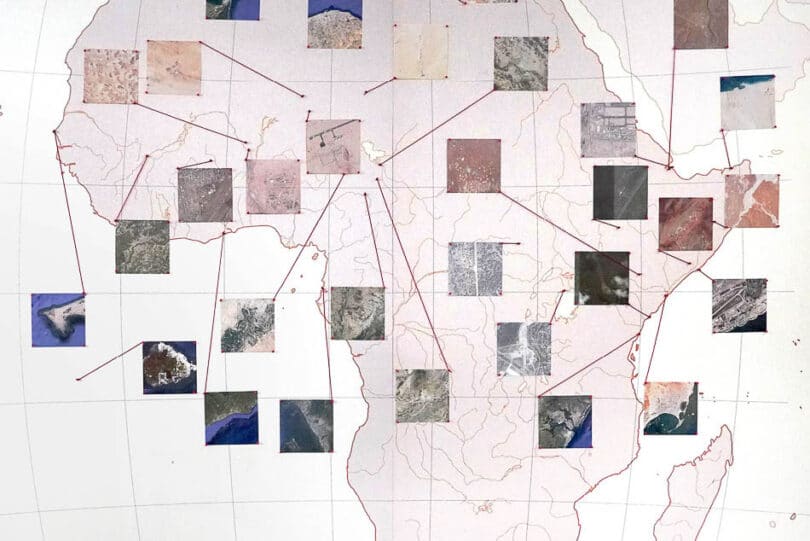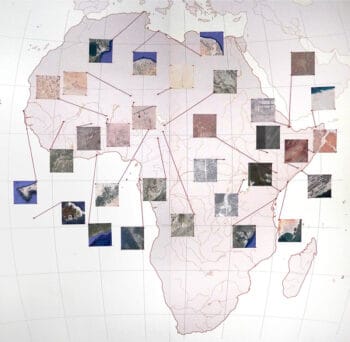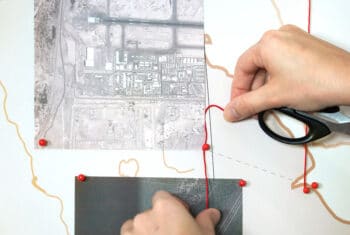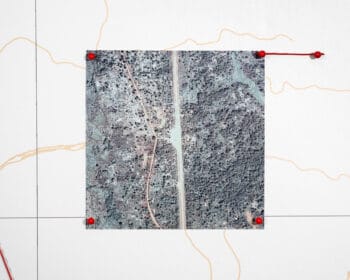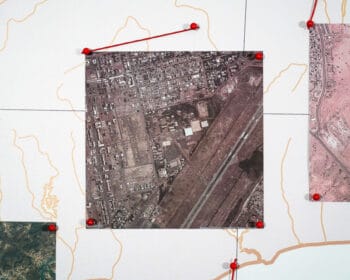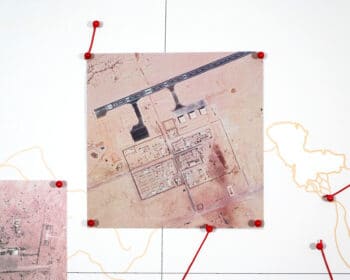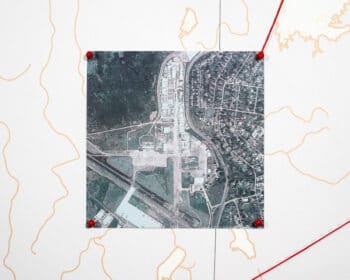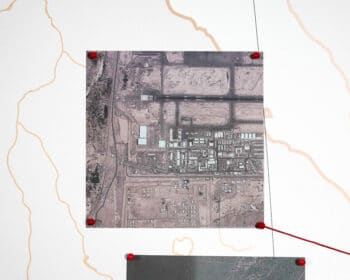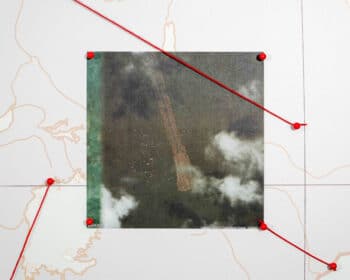Dossier no. 42 Co-publication with The Socialist Movement of Ghana’s Research Group
How do you visualise the footprint of Empire?
The images in this dossier map some of AFRICOM’s military bases on the African continent–both ‘enduring’ and ‘non-enduring’, as they are officially called. The satellite photos were gathered by data artist Josh Begley, who led a mapping project to answer the question: ‘how do you measure a military footprint?’
For this dossier, Tricontinental: Institute for Social Research physically projected images and coordinates of these hidden-away sites onto a map of Africa, visually reconstructing the apparatus of militarisation today.
Meanwhile, the pins and thread connecting these places remind us of the ‘war rooms’ of colonial domination. Together, the set of images is a visual testament to the continued ‘fragmentation and subordination of the continent’s peoples and governments’, as this dossier writes.
We refuse simple survival. We want to ease the pressures, to free our countryside from medieval stagnation or regression. We want to democratise our society, to open up our minds to a universe of collective responsibility, so that we may be bold enough to invent the future. We want to change the administration and reconstruct it with a different kind of civil servant. We want to get our army involved with the people in productive work and remind it constantly that, without patriotic training, a soldier is only a criminal with power. That is our political programme.
On 30 May 2016, the African Union’s Peace and Security Council (PSC) held its 601st meeting. Though the agenda was broad, members of the PSC came to the meeting concerned about a range of conflicts: the collapse of the Libyan state and the impact that this had across the Sahel, the ongoing struggles in the Lake Chad region with the persistence of Boko Haram, and the wars that marked the Great Lakes region (with the loss of sovereignty by the Democratic Republic of the Congo on its eastern flank). The ‘primary responsibility for ensuring effective conflict prevention’, the PSC noted, ‘lies with the Member States’, namely the fifty-five countries on the African continent from Algeria to Zimbabwe.
The PSC needed no lessons from anyone on its own limitations, which were two-fold:
- Internal fragmentation. Only months before the May meeting, the PSC had authorised the deployment of 5,000 troops from the African Prevention and Protection Mission to Burundi. This was partly due to the enduring causes of the long-standing conflict in the Great Lakes, which included the Burundian Civil War (1993-2005) as well as the political crisis occasioned by President Pierre Nkurunziza’s suffocation of the political system, which led to public protests and state repression in 2015. President Nkurunziza pushed an agenda amongst African heads of governments to block the PSC’s decision. The AU decided that the situation in Burundi had calmed down, despite the fact that the United Nations found evidence of crimes against humanity. This was one example of the fragmentation of the African leadership, which prevented the PSC from moving an agenda.
- External pressures. In February-March 2011, the PSC met to draw up a full-fledged roadmap to dial back the conflict in Libya. A PSC mission gathered at Nouakchott, Mauritania to travel to Tripoli, Libya and open negotiations based on paragraph 7 of the PSC communique. This paragraph–which was known as the ‘roadmap’–contained an elegant four-point pathway, including the cessation of hostilities, delivery of humanitarian assistance through cooperation, protection of foreign nationals, and adoption and implementation of political reforms to eliminate the causes of the crisis. Both the government of Libya and the opposition initially rejected the roadmap, but the avenues for dialogue remained open, which is why a PSC mission was ready to go to Tripoli. The day before the PSC mission could leave, France and the United States began to bomb Libya. This bombing took place under the aegis of the North Atlantic Treaty Organisation (NATO) and UN Security Council resolution 1973 (voted on by three African countries: Gabon, Nigeria, and South Africa). The ‘humanitarian intervention’ quickly exceeded the UN mandate of protecting citizens, moving towards regime change using immense violence that resulted in civilian casualties. The disregard shown by the North Atlantic states for the African Union and the PSC has gone by virtually unremarked.
In the aftermath of the NATO war on Libya, the Sahel region experienced a number of conflicts, many of them driven by the emergence of forms of militancy, piracy, and smuggling. Using the pretext of these conflicts, and inflamed by NATO’s war, France and the United States intervened militarily across the Sahel. In 2014, France set up the G-5 Sahel, a military arrangement that included Burkina Faso, Chad, Mali, Mauritania, and Niger, and expanded or opened new military bases in Gao, Mali; N’Djamena, Chad; Niamey, Niger; and Ouagadougou, Burkina Faso. The United States, for its part, built an enormous drone base in Agadez, Niger, from which it conducts drone strikes and aerial surveillance across the Sahel and the Sahara Desert. This is one of the many U.S. bases on the African continent. The United States has twenty-nine known military facilities in fifteen countries on the continent, while France has bases in ten countries. No other country from outside the continent has as many military bases in Africa.
The number of foreign military bases on the African continent alarmed the PSC, which raised this as an important issue in its May 2016 meeting:
Council noted with deep concern the existence of foreign military bases and establishment of new ones in some African countries, coupled with the inability of the Member States concerned to effectively monitor the movement of weapons to and from these foreign military bases. In this regard, Council stressed the need for Member States to be always circumspect whenever they enter into agreements that would lead to the establishment of foreign military bases in their countries.
Since 2016, little advance has been made on the PSC statement. It is telling that the PSC did not name the countries that have the most bases on the continent, a question of quantity that has an impact of the quality of suppression of African sovereignty. Had the PSC named the United States and France as the main countries that have military bases in Africa, it would have had to acknowledge the particular reasons why the U.S. and France continue to require a military presence for their ends.
It is important to acknowledge that these developments are neither the norm for Africa’s modern history nor are they inevitable. In 1965, Ghana’s former President Kwame Nkrumah published an important book, Neo-Colonialism: The Last Stage of Imperialism, which reflected on the phenomenon of military bases. These had been commonplace during the time of high colonialism, with bases across the continent from the British base at Salisbury in former Rhodesia (present-day Harare, Zimbabwe) to the French base at Mers El Kébir in Algeria. Both the British and the United States militaries had bases in Libya, from the Wheelus Air Base to the military posts in Tobruk and El Adem. In return for the land and the right to barrack troops at these places, the UK and the U.S. provided Libya with ‘aid’, which Nkrumah rightly said was a payment for the loss of sovereignty. Here is Nkrumah’s assessment of these bases in Africa:
A world power, having decided on principles of global strategy that it is necessary to have a military base in this or that nominally independent country, must ensure that the country where the base is situated is friendly. Here is another reason for balkanisation. If the base can be situated in a country which is so constituted economically that it cannot survive without substantial ‘aid’ from the military power which owns the base, then, so it is argued, the security of the base can be assured. Like so many of the other assumptions on which neo-colonialism is based, this one is false. The presence of foreign bases arouses popular hostility to the neo-colonial arrangements which permit them more quickly and more surely than does anything else, and throughout Africa these bases are disappearing. Libya may be quoted as an example of how this policy has failed.
In 1964, Egypt’s Gamal Abdel Nasser called for the removal of these bases, and in 1970–after Colonel Muammar Gaddafi overthrew the monarchy–the bases were removed. Five years before this, Nkrumah correctly judged the mood of the Libyan people. This mood, from 1965, runs through to the present. Since it was set up in 2007, the U.S. government’s Africa Command (AFRICOM) has not been able to find a home on the African continent; the headquarters of AFRICOM is in Stuttgart, Germany. The African people continue to pressure their governments not to give in to U.S. demands to shift the AFRICOM headquarters from Europe to Africa.
Neo-colonialism, Nkrumah noted, seeks to fragment Africa, weaken African state institutions, prevent African unity and sovereignty, and thereby insert its power to subordinate the aspirations of the continent for pan-African consolidation. Neither the Organisation of African Unity (1963-2002) nor the African Union (2002 onwards) have been able to realise the two most important principles of pan-Africanism: political unity and territorial sovereignty. The enduring presence of foreign military bases not only symbolises the lack of unity and sovereignty; it also equally enforces the fragmentation and subordination of the continent’s peoples and governments.
The Surrender of Our Sovereignty
In 2018, the U.S. Department of Defense proposed that the U.S. and Ghana agree to a Status of Forces Agreement (SOFA), a $20 million deal that would allow the U.S. military to expand its presence in Ghana. In March, widespread unhappiness of this agreement swept large sections of the population into the streets; opposition parties, who worried about the possibility that the U.S. would build a military base in the country, raised their objections in parliament. By April, Ghana’s President Nana Akufo-Addo said that his government had ‘not offered a military base, and will not offer a military base to the United States of America’. The U.S. Embassy in Accra repeated this statement, saying that the ‘United States has not requested, nor does it plan to establish a military base or bases in Ghana’. The SOFA agreement was signed in May 2018.
It does not require a close reading of the agreement’s text to know that there is in fact the possibility that the U.S. could build a base in the country. Article 5, for instance, states,
Ghana hereby provides unimpeded access to and use of Agreed facilities and areas to United States forces, United States contractors, and others as mutually agreed. Such Agreed facilities and areas, or portions thereof, provided by Ghana shall be designated as either for exclusive use by United States forces or to be jointly used by United States forces and Ghana. Ghana shall also provide access to and use of a runway that meets the requirements of United States forces.
Through this article, the U.S. is permitted to create its own military facilities in Ghana. By any definition, this means that it can set up a base. The surrender of Ghana’s sovereignty also comes to light where the SOFA agreement states (Article 6) that the U.S. would ‘be afforded priority in access to and use of Agreed facilities and areas’ and that said use and access by others ‘may be authorised with the express consent of both Ghana and United States forces’.
Furthermore, Article 3 says that U.S. troops ‘may possess and carry arms in Ghana while on Official duty’ and that the U.S. troops shall be accorded ‘the privileges, exemptions, and immunities equivalent to those accorded to the administrative and technical staff of a diplomatic mission’. In other words, the U.S. troops can be armed and, if they are accused of a crime, they will not be tried in Ghana’s courts.
In March 2018, Ghana’s minister of defence, Dominic Nitiwul, was challenged on a radio station by Kwesi Pratt of the Socialist Forum Ghana (SFG). Nitiwul said that there was nothing peculiar about this agreement, since other African countries–like Senegal–had signed such agreements. Ghana, said Nitiwul, had signed similar agreements with the U.S. in 1998 and 2007, but these were done in secret because there was no tax waiver. Pratt warned that Ghana would be ‘surrendering sovereignty’ in entering this agreement. The general sentiment in the country was opposed to the base, which is why both the Ghanaian government and the U.S. denied that a base would be built.
Pratt was right. The U.S. presence at Kotoka International Airport in Accra became the heart of the U.S. military’s West Africa Logistics Network. By 2018, weekly flights from Ramstein Air Base in Germany landed in Accra with supplies (including arms and ammunition) for the at least 1,800 U.S. Special Forces troops spread out across West Africa. Brigadier General Leonard Kosinski said in 2019 that this weekly flight was ‘basically a bus route’. At the Kotoka airport, the U.S. maintains a Cooperative Security Location. This is a base in all but the name.
The U.S. Footprint
The African continent does not have an unusually large number of foreign military bases. These can be found across the world, from the U.S. bases in Japan to the British bases in Australia. No country has a greater military footprint around the world than the United States. According to the U.S. National Defense Business Operations Plan (2018-2022), the U.S. military manages a ‘global portfolio that consists of more than 568,000 assets (buildings and structures), located at nearly 4,800 sites worldwide’.
In 2019, AFRICOM produced a list of some of its known military bases on the African continent, distinguished between those with an ‘enduring footprint’ (a permanent base) and those with a ‘non-enduring footprint’ or ‘lily pads’ (a semi-permanent base):
| Enduring Footprint | Non-enduring Footprint |
| 1. Chebelley, Djibouti | 1. Bizerte, Tunisia |
| 2. Camp Lemonnier, Djibouti | 2. Arlit, Niger |
| 3. Entebbe, Uganda | 3. Dirkou, Niger |
| 4. Mombasa, Kenya | 4. Diffa, Niger |
| 5. Manda Bay, Kenya | 5. Ouallam, Niger |
| 6. Libreville, Gabon | 6. Bamako, Mali |
| 7. St. Helena, Ascension Island | 7. Garoua, Cameroon |
| 8. Accra, Ghana | 8. Maroua, Cameroon |
| 9. Ouagadougou, Burkina Faso | 9. Misrata, Libya |
| 10. Dakar, Senegal | 10. Tripoli, Libya |
| 11. Agadez, Niger | 11. Baledogle, Somalia |
| 12. Niamey, Niger | 12. Bosaso, Somalia |
| 13. N’Djamena, Chad | 13. Galkayo, Somalia |
| 14. Kismayo, Somalia | |
| 15. Mogadishu, Somalia | |
| 16. Wajir, Kenya
17. Kotoka, Ghana |
The list does not contain the bases where the U.S. uses ‘host nation facilities’, such as in Singo, Uganda and in Theis, Senegal.
The large presence of the U.S. Armed Forces on the African continent is not a surprise. The U.S. has the largest military force on the planet, both in terms of the vast number of resources that the U.S. puts into its military and the reach of the military via its base structure as well as its naval and aerial capacity. No other military force in the world matches that of the United States, which spends more on its military budget than the next eleven countries combined. China, which follows the U.S. in military spending, disburses only a third of what the U.S. spends per year.
The footprint of the U.S. military on the African continent is not only quantitatively larger than that of any other non-African country’s bases on the continent, but the sheer scale of the military’s presence and activities gives it a qualitatively different character; this character includes the capacity of the United States to defend its interests on the continent and to attempt to prevent any serious competition to its control of resources and markets. There are two tasks that the U.S. military fulfils on the continent:
- Gendarme functions. The U.S. military operates not only to provide an advantage to the United States and its ruling elites, but it functions–along with the armies of the other NATO nations, including France–as the guarantor of Western corporate interests and the principles of capitalism. Nkrumah came to the same conclusion in 1965, stating that ‘Africa’s raw materials are an important consideration in the military build-up of the NATO countries… Their industries, especially the strategic and nuclear factories, depend largely upon the primary materials that come from the less developed countries’. Reports from the U.S. military routinely sketch out the responsibility of its range of armed forces to ensure a steady stream of raw materials for corporations–especially energy–and to maintain unimpeded movement of goods through shipping channels. Such reports include National Energy Policy (May 2001) from the National Energy Policy Development Group, led by former Vice President Dick Cheney, and Assessing and Strengthening the Manufacturing and Defense Industrial Base and Supply Chain Resiliency of the United States (September 2018) from the Interagency Task Force in Fulfilment of Executive Order 13806. In this sense, the U.S. military–alongside its NATO partners–operates as the gendarme not for the world community, but for the beneficiaries of capitalism. Alongside the U.S. is France, whose military presence in Niger is closely linked to the imperatives of the French energy sector, which requires the uranium mined in Arlit (Niger). One in three French light bulbs are powered by the uranium from this town in Niger, which is garrisoned by French troops.
- The New Cold War. As Chinese private and public commercial interests have increased on the African continent, and as Chinese firms have consistently outbid Western firms, U.S. pressure to contain China on the continent has increased. The U.S. government’s New Africa Strategy (2019) characterised the situation in competitive terms: ‘Great power competitors, namely China and Russia, are rapidly expanding their financial and political influence across Africa. They are deliberately and aggressively targeting their investments in the region to gain a competitive advantage over the United States’. The European Union followed with a report called Towards a Comprehensive Strategy with Africa (2020), which–while it did not directly mention China–worried about ‘competition for natural resources’.
These two points–the gendarme function and the New Cold War–require further elaboration.
Resource Exploitation
Africa is the world’s second-largest landmass with the second-largest continental population (1.34 billion people in 2020) – more than the population of North America and Europe combined (1.1 billion people). Asia is the largest continent with the largest population (4.64 billion people).
Africa’s subsoil holds a range of important natural resources: 98% of the world’s chromium, 90% of its cobalt, 90% of its platinum, 70% of its coltan, 70% of its tantalite, 64% of its manganese, 50% of its gold, and 33% of its uranium, as well as a significant share of the world’s reserves of other minerals such as bauxite, diamonds, tantalum, tungsten, and tin. The continent holds 30% of all mineral reserves, 12% of known oil reserves, 8% of known natural gas, and 65% of the world’s arable land. The UN Environmental Programme estimates that Africa’s natural capital accounts for between 30% and 50% of the total wealth of African countries. In 2012, the UN estimated that natural resources accounted for 77% of total exports and 42% of total government revenue.
African states’ reliance upon the export of raw materials of various kinds–due to the power of multinational corporations and the lack of sufficient industrialisation in a range of African countries–has put them in a position of dependency on foreign capital. This condition of dependency was structured by the policies of the colonial rulers, who maintained economic activity in Africa based on the extraction and growth of raw materials which were then sold through colonial concessions to the countries of their rulers. This dependency was inherited by generations of post-colonial elites, who derived rents from it and did nothing to alter the structure. African states, therefore, rely upon external revenues from the export of raw materials, on aid programmes from Western governments, and on institutional aid.
Such dependency creates undue avenues for manipulations by these foreign governments who have a permanent interest in Africa. Ruling governments use the endowed natural resources to secure aid from foreign partners without paying particular attention to the aid requirements and conditions. These aid terms leech African countries of necessary revenues. For instance, the UN Economic Commission for Africa reports that over the past fifty years, illicit financial flows have resulted in the loss of at least $1 trillion, ‘a sum nearly equivalent to all the official development assistance the continent received during the same period’. These are precious funds that could be used to diversify African economies, build missing infrastructure, and enhance social wages on the continent. Economic dependency narrows the options for African governments, which become more and more subordinate to foreign interests and powers. Amongst governments who are economically subordinated, the political will to resist military intervention–from establishing new foreign bases to allowing foreign militaries to operate in a myriad of other ways–is negligible.
Several pan-African platforms have emerged over the past decade to rectify this dependency, including the African Alternative Framework for Structural Adjustment Programmes for Socio-economic Recovery and Transformation (1989), the Africa Mining Vision (2008), the Gaborone Declaration for Sustainable Development in Africa (2012), the Arusha Declaration on Africa’s Post Rio+20 Strategy for Sustainable Development (2012), the African Development Forum’s communique at the eighth summit (2014), and then culminating in the African Union’s adoption of the First Ten-Year Implementation Plan (2014-2023), outlined in the third document of Agenda 2063: The Africa We Want (2015). Each of these documents–with different levels of emphasis–points to the need to break the reliance on raw material exports, better manage the contracts signed with multinational companies, and use the resources earned from exports to improve the conditions of social life as encapsulated in the UN agreements on Sustainable Development Goals.
The failure to properly harness resources and drive a people-centred development programme produces the social context for both political and military conflicts, including insurgencies that are often refracted along ethnic and religious lines, and for the expansion of migration around the continent and towards Europe. These two results of the deeper economic crisis of African states–conflict and migration–produce the surface-level excuse for countries like the United States and France to establish military bases on the continent.
- Conflict. The U.S. government has established regular military relations–including lily pad bases–in São Tomé and Príncipe in the Gulf of Guinea. On the one hand, explanations for the U.S. presence there do not shy away from directly saying that this is about the movement of Nigerian and Gulf of Guinea oil to the US; Nigeria, a member of Organisation of Petroleum Exporting Countries, is the eleventh largest oil producer in the world. On the other hand, the U.S. government says that it has a military presence in the Gulf of Guinea to stem the growth of Islamic militancy, particularly ISIS and al-Qaeda, even though government officials agree that these groups do not have a threatening presence there.
In Central Africa, AFRICOM has been engaged for over a decade in training the army of the Democratic Republic of the Congo (DRC), particularly in Camp Base, a military base just outside of Kisangani. According to a communiqué by AFRICOM in 2010, the military training would be ‘part of a long-term, multi-lateral US-DRC partnership to promote security sector reform in the country, [which] will assist the DRC government in its ongoing efforts to transform the Armed Forces of the DRC’. These relations between the DRC and AFRICOM have since deepened.
A large discovery of oil (estimated to be 1.7 billion barrels) was made at the border of Congo and Uganda in the Lake Albert region in 2007. It is no surprise, therefore, to see that this region became heavily militarised. This is particularly evident in the town of Beni, North Kivu. Beni is the epicentre of scores of gruesome murders often attributed to the Ugandan rebel group called the Allied Democratic Forces (ADF), which has operated in the Congo since the early 1990s. On 27 January 2021, a delegation of AFRICOM officers arrived in the DRC to discuss with the Congolese military the need for ‘cooperation and engagements, security and stability efforts, and working together to further professionalise the DRC military and strengthen ties’.
On 10 March 2021, the U.S. State Department designated the ADF as a ‘Foreign Terrorist Organisation’ and ‘Specially Designated Global Terrorists’, although local organisations and the UN Group of Experts on the DRC say that there is no evidence to link the ADF to ISIS. The U.S. State Department adopted this stance based on a claim made by the Bridgeway Foundation, the charity arm of the Texas-based investment firm Bridgeway Capital Management. This designation allows for an increased U.S. military presence in the Congo. The main area for this presence will be adjacent to the oil reserves. The U.S. military will also continue to provide stability for the African strongmen, who have come to rely on U.S. support for their longevity.
- Migration. IMF-driven austerity programmes and the failure of African states to manage resource sales in a way that provides decent lives for the population have resulted in large-scale migration across the continent. A quarter of the close to 41.3 million migrants displaced due to violence and conflict have attempted to migrate to Europe, while the rest have moved around within the continent. The migrants who wish to go to Europe travel across the Sahara Desert to Libya, broken by the NATO war, and then cross the Mediterranean Sea. The journey is dangerous, but when the UN surveyed those who made it across the sands and the waters, more than 90% of the migrants that they would do it again.
European attempts to stop the flow of migrants across the Mediterranean Sea have been futile. Foreign militaries have been used in the Sahel to limit migration and keep migrants as far as possible from the European border. That is partly why France assembled the G5 Sahel Initiative and why the U.S. built the large drone base in Agadez, which provides important aerial surveillance of migration in the region. What the countries of Europe have done is to export their borders far from their own territory and to make sure that the harsh interdiction of refugees and migrants is done outside the coverage of their own media. This is a kind of arms-length outsourcing of the refugee crisis: the West gets to drive its terrible anti-migrant policies at the same time as it gets to appear innocent while its subsidiaries do its dirty work. Europe has moved its southern border from the northern edge of the Mediterranean Sea to the southern rim of the Sahara Desert, now dotted with military bases from Mauritania to Chad.
The surface arguments of conflict prevention and migration management are commonplace. But, once in a while, deeper motivations are clarified by some U.S. officials. As Commodore John Nowell, who runs the Africa Partnership Station of AFRICOM, said in 2008, ‘We wouldn’t be here if it wasn’t in [US] interests’. By ‘here’, Commodore Nowell meant the African continent.
The New Cold War
In the U.S. government’s 2006 Quadrennial Defense Review, the authors wrote that, ‘Of the major and emerging powers, China has the greatest potential of any nation to militarily compete with the U.S. and field disruptive military technologies that could over time offset traditional U.S. advantages’. In fact, China’s military capacity is largely defensive, since China has built up its military abilities in order to defend its coastline and its territory. China’s Foreign Minister Wang Yi has emphasised that his country is committed to multilateralism: ‘China never seeks global hegemony’, he said on 24 April 2021. What the U.S. planners more precisely indicate is that they would not like to see Chinese commercial and political power challenge the overall hegemony of the United States. As Commodore Nowell put it, U.S. interests are the reason for the country’s presence in the region; any threat to those interests must be undermined by any means necessary.
In 2013, the Chinese government inaugurated the Belt and Road Initiative (BRI). Prior to the formalisation of the BRI, the Forum on China-Africa Cooperation was set up in 2000 between Beijing and, initially, forty-four African countries (fifty-three out of fifty-five countries on the continent have since established relations with China under the Forum). Since 2013, China has invested in almost all African countries, all of which–except for Eswatini (formerly Swaziland)–have broken ties with Taiwan and recognised the People’s Republic of China.
Over the years, China has signed several Memorandums of Understanding with the African Union, including one in 2015 within the framework of Agenda 2063 to support building infrastructure. China has invested large amounts of money in key infrastructure such as the Mali-Guinea rail project and the Sudan-Senegal railway line; in energy infrastructure, such as a 2600MW Mambilla hydropower project in Nigeria and the 400MW Bui Dam in Ghana; and in telecommunications, such as telecom equipment for Ethiopia, Ghana, Kenya, and Sudan. In December 2020, construction began on the new China-funded $80 million Africa Centres for Disease Control and Prevention headquarters south of Addis Ababa in Ethiopia. There are now about 600 completed BRI projects globally.
Chinese aid–unlike IMF aid, Western commercial investment, and overseas development assistance–does not come with the vice of debilitating conditionalities. Evidence for more favourable terms comes in the various agreements signed by China, but more than that, it comes from China’s theory of patient capital, which has until now been adopted within the boundaries of China but has slowly–through Chinese state banks–emerged as a major investor outside its territory. China is now the second-largest investing country in the world, with the China Export-Import Bank and China Development Bank being major investors. The loans that these state agencies provide are long-term investments and are not on short repayment schedules. China fully understands that its loans are given to release infrastructure bottlenecks and to therefore support social development. Borrower countries are given flexibility as benefits are forecast to come in the long-term. For example, 30% of the investment in Central Asia and 80% of the investment in Pakistan will not be recovered.
Rather than develop its own humane commercial and development aid policy that would benefit the African people, the United States has opened up a ‘new cold war’ against China on the African continent. The development of AFRICOM in 2007 alongside the escalation of U.S. and allied foreign military bases in the Sahel, the Horn of Africa, and elsewhere are part of this New Cold War. Fundamentally, the New Cold War has been structured by a (mis)information war, which consists of two main elements:
- China’s new ‘colonialism’. Stunningly, the old colonial powers, which continue a neo-colonial policy towards China Africa–as illustrated by Nkrumah and evident in the base structure–now turn their gaze on China and accuse it of being a colonial power. The main rhetoric used in this (mis)information war is that China allegedly uses its financial resources to ensnare countries in a debt trap, which forces these countries to hand over their resources at low prices. The term ‘debt trap diplomacy’ is used against China, and yet it was not China that enforced structural adjustment loans that drew most African countries into a cataclysmic debt trap that has only deepened during the pandemic. It was not China, but the IMF, which carried forward a policy framework driven by the U.S. Treasury Department. While the U.S. accuses China of ‘refusing to renegotiate terms [of loans], and then taking control of the infrastructure itself’, the reality is that Chinese lenders have cancelled, deferred, and restructured terms of existing loans (before and during the pandemic) and have never seized sovereign assets from any country. Two senior U.S. professors published an article in The Atlantic in February 2021 with the telling title ‘The Chinese “Debt Trap” is a Myth’. The charge of colonialism against China is made by countries that have a well-documented history of colonialism and neo-colonialism in Africa.
- China’s military capacity. The old colonial powers accuse China of building up its military presence in Africa. Reviving a false and dated trope, AFRICOM commander General Townsend recently made unsubstantiated claims that China seeks to build a naval base on the coast of West Africa. In fact, China’s military presence is negligible compared to the Western military footprint. In 2008, China joined the anti-piracy manoeuvres in the Horn of Africa and the Gulf of Aden; these operations were based on UN Security Council resolution 1816 (2008), which asked member states of the UN to provide the transitional government in Somalia with ‘all necessary means to repress acts of piracy and armed robbery’. A decade into these operations, China developed its first overseas military base in Djibouti. The purpose of this base was twofold, first to provide logistical support for escort vessels for Chinese tankers in the Gulf of Aden, and second to support the multinational anti-piracy campaigns. At the same time, in the highly militarised region of the Horn of Africa, the Chinese government financed the construction of the Ethiopian-Djiboutian electric railway under a $4 billion project, while the China Export-Import Bank provided funding for more than $300 million on a water pipeline to bring potable drinking water from Ethiopia to Djibouti. China’s approach to peace is qualitatively different from Western foreign military activities that focus on gendarme functions and armament, choosing instead to focus on infrastructure-led economic development and poverty alleviation.
The African Union
In 2016, the African Union (AU) raised the issue of foreign military bases on the African continent. The discussion has not been deepened since then. The African Union’s dependence on external funding and resources for its operations, including peacekeeping, has limited its freedom to take independent, strategic, and tactical decisions in its operations. For peacekeeping, for instance, African states raise only 2% of the cost of the AU’s peace and security operations, while foreign funders–such as the European Union–provide 98% of the funds. This has constrained the ability of the Peace and Security Council to drive its own agenda and is why the AU has not been able to effectively continue the discussion around the foreign military bases.
On 15 October 2003, Nile Gardiner and James Carafano of the Heritage Foundation in the U.S. published a white paper called US Military Assistance for Africa: A Better Solution. They argued that the U.S. government should create a U.S. Africa Command that would intervene in Africa ‘when vital [US] national interests are threatened’ in the same tradition as was done in Latin America and the Caribbean with the establishment of the U.S. Southern Command in 1963. This became a reality in 2007. Two African countries, Botswana and Liberia, indicated that they would be pleased to house the headquarters of AFRICOM. At that time, South Africa voiced opposition to AFRICOM’s move to the continent. Through AU intervention, both Botswana and Liberia backed off.
The mood to prevent AFRICOM’s headquarters from being based on the continent remains amongst the African people. However, this has not stopped U.S. and some African heads of state. In a meeting with the U.S. Secretary of State Blinken on 27 April 2021, Nigerian President Muhammadu Buhari asked the U.S. to relocate AFRICOM Headquarters from Stuttgart, Germany to the African continent in order to help fight insurgencies. Growing pressure from Islamic and other dissidents and increased instability in Nigeria may have been a contributing factor to President Buhari’s appeal, though he fell short of suggesting Nigeria as host for AFRICOM. Nigeria’s position is a major shift from its initial stand which, a decade ago, was against the presence of AFRICOM in Africa. Nonetheless, U.S. military bases proliferated after that date. The AU referred to the danger of this proliferation in 2016 but, even at that time, all that the AU could muster were the tepid words: ‘concern’ and ‘circumspect’. Despite these words, AFRICOM insinuated itself into the AU with an attaché to the PSC and staff in the AU Conflict Prevention and Early Warning Division, as well as the Peace Support Operations Division. With the entry of AFRICOM into the AU in the name of ‘interoperability’ to link U.S. military forces with AU peacekeepers, the U.S. has begun to shape the AU’s security framework more directly.
In his book on neo-colonialism in Africa, Nkrumah wrote:
The danger to world peace springs not from the action of those who seek to end neo-colonialism but from the inaction of those who allow it to continue. … If world war is not to occur it must be prevented by positive action. This positive action is within the power of the peoples of those areas of the world which now suffer under neo-colonialism but it is only within their power if they act at once, with resolution and in unity.
These words from 1965 ring true today.
References:
Campbell, Horace G. ‘The Quagmire of U.S. Militarism in Africa’, Africa Development 45, no. 1 (2020): 73-116.
Charbonneau, Bruno. ‘De Serval à Barkhane: les problèmes de la guerre contre le terrorisme au Sahel’, Les Temps Modernes 2 (2017): 322-340.
de Montclos, Marc-Antoine Pérouse. ‘La politique de la France au Sahel: une vision militaire’, Hérodote 172, no.1 (2019): 137-152.
Enloe, Cynthia. Bananas, Beaches and Bases: Making Feminist Sense of International Politics. Berkeley: University of California Press, 1990.
Evrard, Camille. ‘Policier le désert. Ordre colonial, <<guerriers nomades>> et État postcolonial (Niger et Mauritanie, 1946-1963)’, Vingtiéme Siècle. Revue d’Histoire 4, no. 140, (2018): 15-28.
Gwatiwa, Tshepo, and Justin van der Merwe, eds. Expanding U.S. Military Command in Africa: Elites, Network, and Grand Strategy. New York: Routledge, 2020.
Klin, Tomasz. ‘The Significance of Foreign Military Bases as Instruments of Spheres of Influence’, Croatian International Relations Review 26, no. 87 (2020): 120-144.
Lutz, Catherine, and Cynthia Enloe, eds. The Bases of Empire: The Global Struggle against U.S. Military Posts. New York: New York University Press, 2009.
Luzzani, Telma. Territorios vigilados: Como opera la red de bases militares norteamericanas en Sudamérica. Buenos Aires: Debate, 2012.
Nkrumah, Kwame. Neo-colonialism: The Last Stage of Imperialism. New York: International Publishers, 1965.
Sun, Degan, and Yahia Zoubir. ‘Sentry Box in the Backyard: Analysis of French Military Bases in Africa’, Journal of Middle Eastern and Islamic Studies (in Asia) 5, no. 3 (2011): 82-104.
Turse, Nick. ‘Pentagon’s Own Map of U.S. Bases in Africa Contradictions Its Claim of “Light” Footprint’, The Intercept, 27 February 2020.
United States Government Accountability Office. DOD Needs to Reassess Options for Permanent Location of U.S. Africa Command: Report to Congressional Committee. Washington, DC: GAO 13/646, 2013.
United States Africa Command Public Affairs Office. Fact Sheet: United States Africa Command. 15 April 2013.
Wang, Lei. ‘China and the United States in Africa. Competition or Cooperation?’, China Quarterly of International Strategic Studies 6, no. 1 (2020): 1–19.
Vine, David. ‘No Bases? Assessing the Impact of Social Movements Challenging U.S. Foreign Military Bases’, Current Anthropology 60, no. S19 (February 2019): S158-S172.
Vine, David. Base Nation: How U.S. Military Bases Abroad Harm America and the World. New York: Metropolitan Books, 2015.
Yeo, Andrew. ‘The Politics of Overseas Military Bases.’ Perspectives on Politics 15, no. 1 (March 2017): 129-136.
Yeo, Andrew. Activists, Alliances, and Anti-U.S. Base Protests. New York: Cambridge University Press, 2011.

